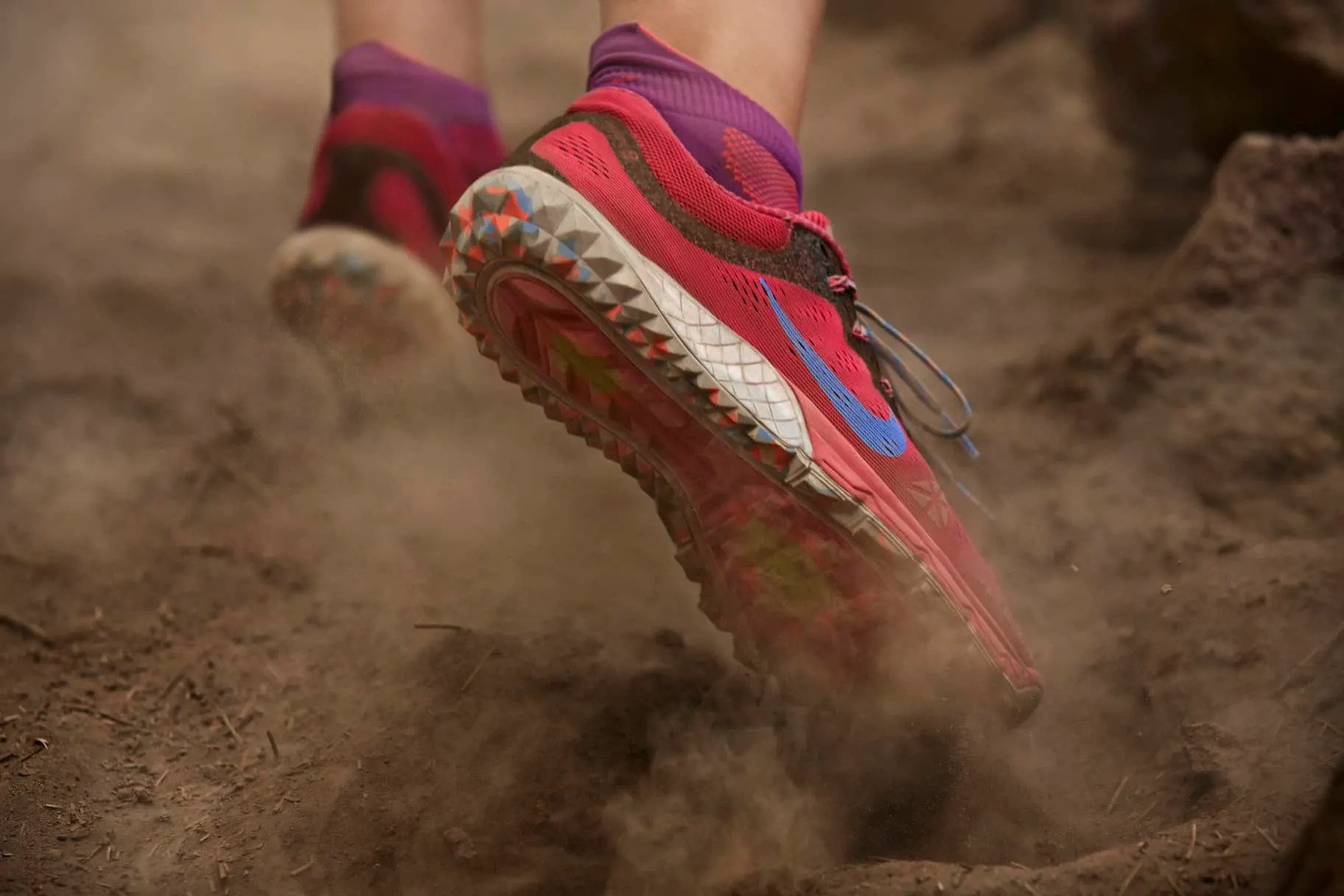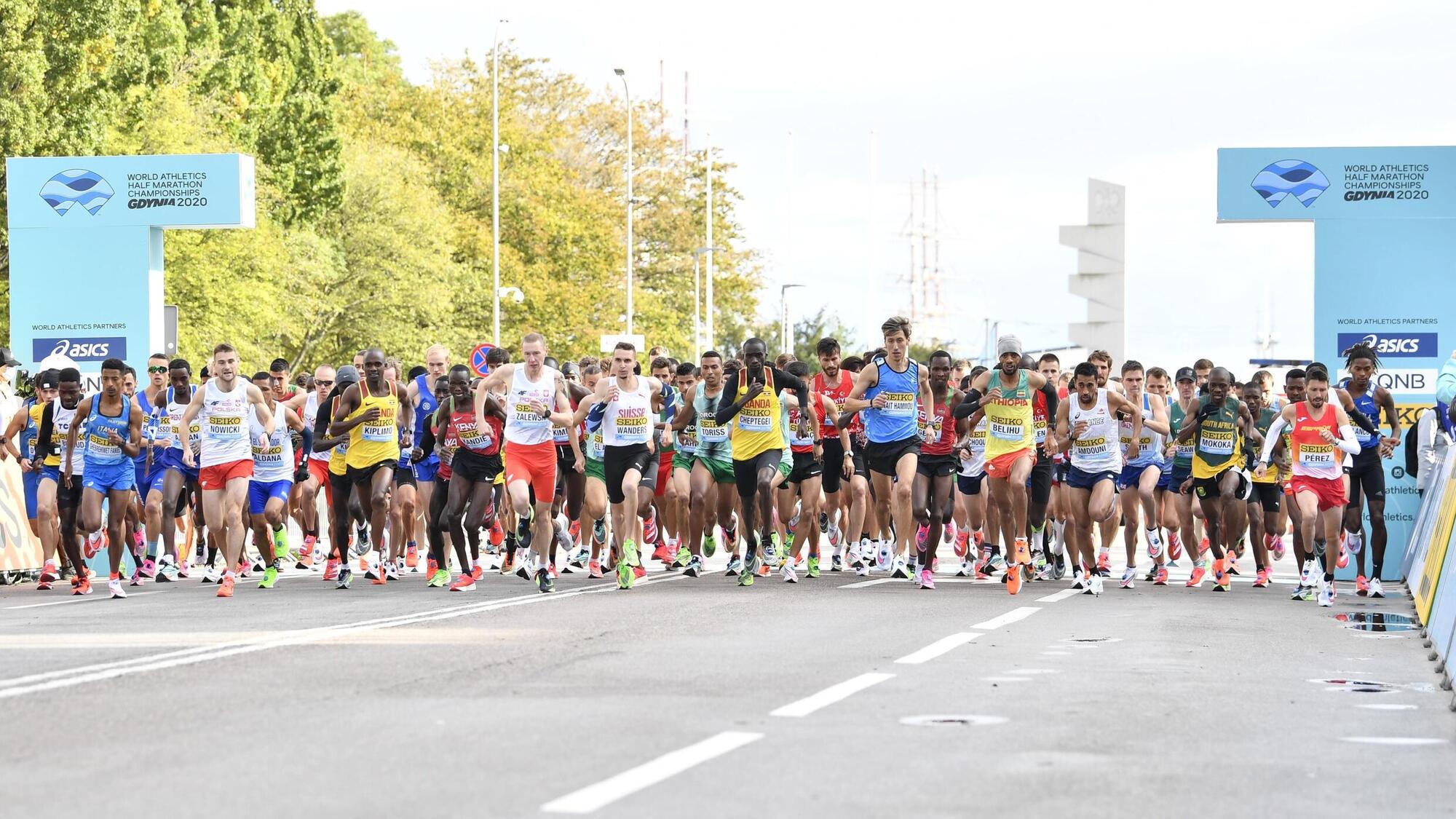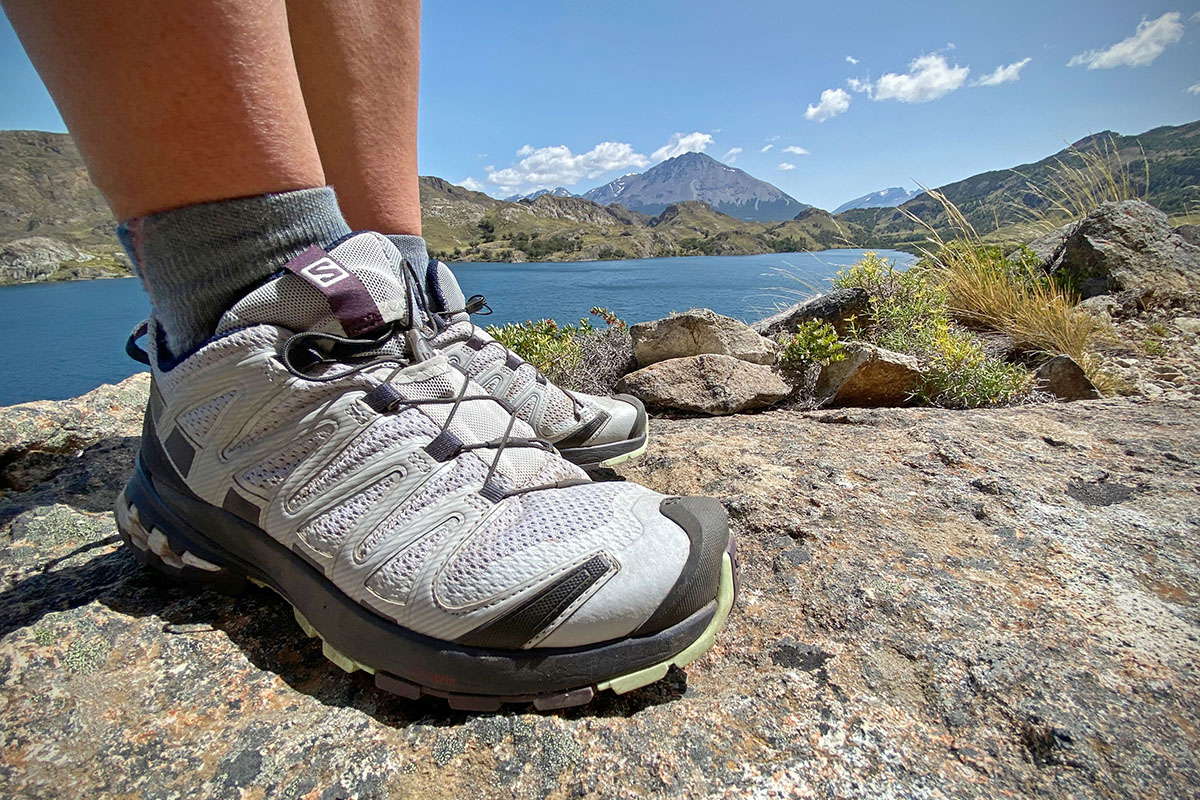

Featured
How To Train For Trail Running
Modified: March 1, 2024
Learn the essential training techniques and tips on how to excel in trail running with our featured guide. Enhance your endurance and conquer challenging terrains.
Introduction
Trail running is a thrilling and adventurous sport that combines the joy of running with the beauty of nature. Unlike road running, trail running takes you off the beaten path and onto rugged terrains, including mountains, forests, and scenic trails. Whether you are a seasoned runner looking for a new challenge or a nature enthusiast seeking a way to explore the great outdoors, trail running is a fantastic option.
Trail running offers a wide range of benefits for both the body and the mind. It provides a full-body workout, engaging muscles that are not commonly used in road running. The uneven surfaces and varying elevations of trail running demand more balance and stability, thereby strengthening the core and improving overall agility. In addition to the physical benefits, trail running is also a great way to reduce stress and boost mental well-being. The tranquil surroundings and connection to nature can uplift the spirits and provide a sense of serenity.
To fully enjoy the experience of trail running, it is important to have the right gear. Unlike road running, trail running requires specific equipment that can handle the rugged terrain. Trail running shoes with aggressive treads are essential for providing traction and stability on uneven surfaces. It is also advisable to have moisture-wicking clothing, a lightweight backpack for carrying water and supplies, and a hat or sunglasses to protect against the elements.
Choosing the right trail is crucial for an enjoyable and safe trail running experience. There are trails suitable for all fitness levels, ranging from beginner-friendly paths to more challenging routes. Factors such as distance, elevation gain, terrain, and accessibility should be taken into consideration when selecting a trail. It is recommended to start with shorter, less technical trails and gradually progress to more difficult ones as your fitness and confidence improve.
Trail running requires a certain level of endurance, strength, and proper technique. Building endurance is key to tackling longer distances and challenging terrains. Incorporating interval training, long runs, and cross-training activities into your workout routine can help improve cardiovascular fitness and stamina. Strength training is also essential, as it aids in injury prevention and enhances overall performance. Exercises that target the lower body, such as squats, lunges, and calf raises, are particularly beneficial for trail runners.
In addition to endurance and strength, mastering the proper technique and form is important for trail running. Maintaining a slight forward lean, lifting your feet to clear obstacles, and using your arms for balance can help navigate the uneven terrain more efficiently. It is also crucial to learn how to descend and ascend hills effectively to preserve energy and prevent injuries. Practicing these techniques on different types of trail surfaces will gradually improve your trail running skills.
Benefits of Trail Running
Trail running offers a multitude of benefits for both the body and mind. Here are some of the key advantages of engaging in this exhilarating sport:
- Full-body workout: Trail running engages a wider range of muscles compared to road running. The uneven terrain and varying elevations require constant adjustments in balance and stability, activating muscles in the core, hips, and lower body. This leads to a stronger and more toned physique.
- Improved cardiovascular fitness: The challenging nature of trail running, with its hills and variable terrain, provides an excellent cardiovascular workout. It elevates the heart rate and strengthens the heart, leading to improved endurance and overall cardiovascular health.
- Enhanced mental well-being: Spending time in nature has been shown to have a positive impact on mental health. Trail running offers not only the physical benefits of exercise but also the tranquility and beauty of natural surroundings. It can reduce stress levels, boost mood, and promote a sense of peace and mindfulness.
- Connection with nature: Trail running allows you to explore breathtaking landscapes, from lush forests to majestic mountain ranges. It provides a unique opportunity to immerse yourself in nature, appreciate its beauty, and experience a sense of connection with the natural world.
- Variety and excitement: Running on trails brings a sense of adventure and excitement. Every trail is different, offering a new challenge and a chance to explore uncharted territories. It breaks the monotony of running on paved roads and keeps you motivated and engaged in the sport.
- Injury prevention: Trail running can be gentler on the body compared to road running. The natural surfaces of trails provide more cushioning for the joints, reducing the impact and minimizing the risk of injuries, such as shin splints or stress fractures.
- Boosted balance and coordination: Trail running requires constant adjustments to the changing terrain, making it an excellent activity for improving balance and coordination. Negotiating twists, turns, and obstacles helps train proprioception and body awareness.
Overall, trail running offers a holistic approach to fitness, combining physical exertion with the soothing power of nature. It provides a unique and invigorating experience that can rejuvenate both the body and mind, making it a perfect choice for those seeking an adventurous and fulfilling workout.
Essential Gear for Trail Running
Trail running requires specific gear to ensure comfort, safety, and optimal performance on rugged terrains. Here are the essential items you will need to make the most out of your trail running experience:
- Trail Running Shoes: Invest in a pair of trail running shoes that offer good traction, stability, and protection. Look for shoes with aggressive outsoles and durable construction to handle uneven surfaces, rocks, and muddy trails. It is also important to choose shoes that fit well and provide ample support to prevent foot fatigue and reduce the risk of injuries.
- Moisture-Wicking Clothing: Opt for moisture-wicking and breathable clothing to keep you comfortable during your runs. Choose lightweight and quick-drying fabrics that help regulate body temperature and wick sweat away from the skin. Consider wearing a moisture-wicking base layer, a breathable top, and comfortable shorts or leggings depending on the weather conditions.
- Hydration System: Staying hydrated is crucial when trail running, particularly on longer runs or in hot weather. Carry a hydration system that suits your preferences, such as a hydration pack, handheld water bottle, or waist belt with water bottle holders. Make sure to practice using it before your runs to determine the most comfortable and efficient method.
- Protection Against the Elements: Depending on the weather and trail conditions, consider bringing essential items for protection. Wear a hat or visor and sunglasses to shield your eyes from the sun and keep debris out. Don’t forget to apply sunscreen to protect your skin from harmful UV rays. In cooler or unpredictable weather, bring a lightweight waterproof jacket or a windbreaker as a precaution.
- Trail Map and Navigation Tools: When exploring new trails, always carry a trail map or use a GPS device or mobile app specifically designed for trail running. Familiarize yourself with the route beforehand and be prepared to navigate any unexpected detours or changes. This will help you stay on track and make the most of your trail running adventure.
- Headlamp or Light Source: If you plan to trail run during dusk or dawn or in areas with limited lighting, bring a reliable headlamp or a handheld light source. This will ensure visibility and safety, especially on trails with uneven terrain or obstacles.
- First Aid Kit: It is always advisable to carry a basic first aid kit in case of minor injuries, such as cuts, blisters, or sprains. Include items like adhesive bandages, blister pads, athletic tape, antiseptic wipes, and any personal medication you may require.
- Trail Running Backpack or Waist Belt: Depending on the length and intensity of your runs, consider using a lightweight backpack or waist belt to carry your essentials, such as water, snacks, a phone, keys, and any extra layers you may need. Look for options that provide a snug fit, minimal bounce, and easy access to your belongings.
Investing in the right gear will not only enhance your comfort and safety but also optimize your performance on the trails. Therefore, make sure to select high-quality gear that suits your individual needs and preferences, allowing you to fully enjoy the exhilarating experience of trail running.
Selecting the Perfect Trail
Choosing the right trail is crucial for a rewarding and enjoyable trail running experience. With countless options available, consider the following factors when selecting the perfect trail:
- Distance and Difficulty: Determine your current fitness level and running abilities to gauge the distance and difficulty that suits you best. If you’re new to trail running, start with shorter and less technical trails. As your fitness and confidence improve, gradually progress to longer distances and more challenging terrains.
- Terrain: Assess the terrain of the trail you’re considering. Trails can vary from well-groomed paths to rocky, steep, or muddy terrains. Beginners may prefer smoother surfaces, while experienced trail runners may seek more technical and varied terrains for an additional challenge.
- Elevation Gain: Take note of the elevation gain of the trail, as it has a significant impact on the difficulty level. Steep climbs and descents can test your cardiovascular fitness and leg strength. Determine how much elevation gain you’re comfortable with and gradually increase it as you progress.
- Scenery and Natural Features: Consider the kind of scenery and natural features you want to experience during your trail run. Whether it’s lush forests, mountain vistas, coastal views, or waterfalls, choose a trail that offers the beautiful landscapes that inspire and motivate you.
- Accessibility: Evaluate the accessibility of the trail in terms of location, parking, and ease of getting there. Trails closer to home or within a reasonable distance are convenient, especially for regular training sessions. Check if there are any parking fees or permits required.
- Trail Conditions: Research the current trail conditions and take note of any potential hazards or closures. Trail conditions can vary throughout the year, so it’s essential to stay informed about weather-related concerns, such as excessive mud, snow, or flooding.
- Trail Safety: Prioritize your safety when choosing a trail. Opt for well-marked and well-traveled trails, particularly if you’re new to trail running. Inform someone about your planned route and estimated time of return. Consider running with a buddy or joining a local trail running group for added safety and camaraderie.
- Personal Preferences: Finally, consider your personal preferences, such as solitude vs. more populated trails or trails with amenities like restrooms or water fountains. Reflect on the type of experience you wish to have and choose a trail that aligns with your preferences.
Remember that trail running is a journey of exploration and self-discovery. Embrace the variety of trails available and be open to trying different ones. Each trail offers its own unique experience, allowing you to connect with nature, challenge yourself, and find joy in the beauty of the outdoors.
Building Endurance for Trail Running
Building endurance is crucial for trail running, as it allows you to tackle longer distances and more challenging terrains with ease. Here are some effective strategies to help you build endurance and improve your trail running performance:
- Consistent Training: Consistency is key when it comes to building endurance. Incorporate regular trail running sessions into your training schedule and aim for gradual progression. Start with shorter distances and gradually increase the duration and intensity of your runs over time.
- Long Runs: Include at least one long run in your weekly training plan. Long runs help to condition your body for the demands of longer trail runs by gradually increasing your time on your feet. Start with a distance that challenges you but is still manageable, and then gradually increase the distance each week.
- Interval Training: Interval training involves alternating between high-intensity bursts of running and periods of active recovery. This type of training helps improve cardiovascular fitness and increases your body’s ability to tolerate high-intensity efforts during trail runs. Incorporate intervals into your training by performing short bursts of fast running followed by slower recovery periods.
- Cross-Training: Engage in cross-training activities to complement your trail running. Cross-training, such as cycling, swimming, or strength training, helps to strengthen different muscle groups, prevent overuse injuries, and improve overall fitness. Choose activities that provide variety and help build cardiovascular endurance.
- Hill Repeats: Hill repeats are an excellent way to build endurance and strength specifically for trail running. Find a hill with a moderate incline and run up at a challenging pace, then recover by jogging or walking down. Repeat the uphill sprint several times to improve your uphill running ability and increase endurance.
- Progressive Overload: Gradually increase the intensity and duration of your runs to give your body time to adapt and improve. This principle of progressive overload helps stimulate physiological adaptations, such as increased muscle endurance and cardiovascular capacity. Avoid sudden or drastic increases in training volume, as this can lead to overuse injuries.
- Rest and Recovery: Allow time for adequate rest and recovery between your training sessions. Rest days are essential for your body to repair and adapt to the training stress. Listen to your body and don’t push through excessive fatigue or pain. Incorporate rest days and recovery activities, such as stretching, foam rolling, or yoga, into your training program.
- Mental Training: Endurance is not only physical but also mental. Develop mental strategies to push through fatigue and stay focused during long trail runs. Practice positive self-talk, visualization, and goal-setting to enhance mental toughness and overcome challenging moments on the trails.
Building endurance takes time and dedication, so be patient with yourself and trust the process. By gradually increasing your training volume, incorporating a variety of workouts, and allowing for proper rest and recovery, you’ll gradually develop the endurance needed to conquer longer and more demanding trail runs.
Strength Training for Trail Running
Strength training is a vital component of trail running as it helps to improve running efficiency, prevent injuries, and enhance overall performance. Incorporating strength training exercises into your training regimen can greatly benefit your trail running experience. Here are some key exercises and tips to help you build strength for trail running:
- Lunges: Lunges are a fundamental exercise for building lower body strength. Incorporate forward lunges, reverse lunges, and lateral lunges into your workout routine to target the quadriceps, hamstrings, and glutes. Lunges also help improve balance and stability on uneven terrains.
- Squats: Squats are a compound exercise that targets multiple muscle groups in the lower body, including the quadriceps, hamstrings, and glutes. Performing both bodyweight squats and weighted squats with a barbell or dumbbells can strengthen the legs and help improve power and stability during trail running.
- Calf Raises: Strong calf muscles are essential for navigating tricky terrain and absorbing impact. Perform calf raises on a raised surface or with the assistance of a step or a calf raise machine at the gym. This exercise targets the gastrocnemius and soleus muscles in the calves.
- Single-Leg Exercises: Incorporate single-leg exercises like single-leg squats, step-ups, and Bulgarian split squats to improve balance, stability, and muscular strength. These exercises also help address any muscular imbalances and prevent injury.
- Core Exercises: A strong core is crucial for maintaining proper posture and stability during trail running. Include exercises like planks, Russian twists, and mountain climbers to target the core muscles. Consider adding stability ball exercises to challenge your core even further.
- Hip and Glute Exercises: Strong hip and glute muscles are key for generating power and stability while running on trails. Incorporate exercises like hip bridges, glute bridges, and fire hydrants to strengthen these muscles and improve running form.
- Upper Body Exercises: While trail running primarily activates the lower body muscles, having upper body strength can assist with balance and stability. Include exercises like push-ups, pull-ups, and rows to strengthen the arms, shoulders, and back.
- Functional Exercises: Functional exercises mimic the movements and demands of trail running. Incorporate exercises like step-ups with knee drives, lateral bounds, and agility ladder drills to improve power, agility, and coordination.
- Proper Form and Technique: Focus on maintaining proper form and technique during strength training exercises. This will help maximize the benefits and reduce the risk of injury. If you’re unsure about proper form, consider working with a qualified strength and conditioning professional.
- Gradual Progression: As with any form of training, start with lighter weights or bodyweight exercises and gradually increase the intensity over time. Always listen to your body and avoid pushing yourself too hard or too quickly, as this can lead to overuse injuries.
Incorporating regular strength training sessions into your training plan, along with your trail running workouts, will help build strength, stability, and endurance, enabling you to tackle challenging trails with confidence and minimize the risk of injuries.
Technique and Form for Trail Running
Developing proper technique and form is essential for trail running. It helps improve efficiency, reduce the risk of injuries, and increase overall performance on rugged terrains. Here are some key tips to help you master the technique and form for trail running:
- Body Posture: Maintain a slight forward lean from your ankles to create momentum and drive forward. Avoid leaning back or hunching over, as this can throw off your balance and strain your lower back.
- Arm Swing: Use your arms for balance and to generate power. Keep your arms relaxed and bent at approximately 90 degrees. Let your arms swing naturally in sync with your strides, moving forward and back rather than across your body.
- Foot Placement: Focus on lifting your feet and placing them consciously to clear obstacles and uneven surfaces. This will help prevent tripping and allow for smoother navigation on the trail.
- Shorter Strides: Take shorter and quicker steps on technical or challenging terrain. This helps maintain stability and control by allowing for quicker adjustments to the changing surface. Save longer strides for flatter or more even sections of the trail.
- Uphill Technique: When running uphill, lean slightly forward and use your arms to help drive you forward. Take smaller steps and maintain a consistent effort. It may be more efficient to power hike or walk at a brisk pace on steeper inclines to conserve energy.
- Downhill Technique: Descending requires controlled foot placement and engagement of your core muscles. Lean slightly forward and gravity will assist your descent. Maintain a quick cadence and use your arms for balance. Engage your quads and use them as a braking system to control your speed.
- Efficient Energy Expenditure: Focus on running with a smooth, flowing stride and avoiding unnecessary movements or energy wastage. Minimize side-to-side movements and keep your energy directed forward.
- Terrain Adaptation: Adapt your technique and adjust your stride to match the changing terrain. Different surfaces, such as gravel, rocks, or mud, require different approaches. Practice running on various trail surfaces to familiarize yourself with how they impact your stride and form.
- Practice and Familiarity: Continuously practice running on trails to improve your technique and become more familiar with the demands of different terrains. The more you expose yourself to trail running, the more comfortable and efficient you will become.
- Mindfulness and Concentration: Stay present and aware of your body and surroundings. Focus on maintaining good posture, using your arms for balance, and adapting to changes in the trail. Mindful running can help you react quickly to obstacles and make adjustments on the go.
Remember, developing good technique and form takes time and practice. Start by incorporating these tips into your runs gradually and pay attention to how your body responds. Over time, you will refine and adapt your trail running technique to suit your personal style and the demands of the trails you choose to explore.
Hill Training for Trail Running
Hill training is a crucial component of trail running as it helps build strength, endurance, and mental toughness for tackling challenging uphill and downhill sections. Incorporating hill workouts into your training routine will improve your trail running performance and overall fitness. Here are some effective strategies for hill training:
- Find Suitable Hills: Look for hills of varying grades and lengths where you can perform your hill training. Start with smaller inclines and gradually progress to steeper ones as your strength and fitness improve. Trails with natural elevation changes are ideal for incorporating hill training.
- Uphill Running: Incorporate uphill sprints or moderate-paced uphill runs into your training. Lean slightly forward, use your arms to propel you forward, and take shorter strides to maintain control and efficiency. Focus on maintaining a consistent effort rather than sprinting all-out for the entire hill.
- Downhill Running: Running downhill is equally important in trail running. Practice running downhill with controlled strides and engage your core and leg muscles to absorb the impact. Focus on quick turnover and use your arms for balance. Gradually increase the speed and intensity as you gain confidence and strength.
- Hill Repeats: Hill repeats involve running up a hill at a challenging but sustainable pace and then recovering by walking or jogging back down. Start with a shorter distance, such as 200 meters, and gradually increase the distance or number of repetitions. This training method builds strength, power, and aerobic capacity.
- Long Hill Climbs: Incorporate longer hill climbs into your training to build endurance. Find a sustained uphill section of a trail or road and run at a steady pace, focusing on maintaining good form and rhythm. This will challenge your cardiovascular fitness and mental stamina.
- Cross-Training on Hills: Incorporate hill training into other forms of exercise, such as hiking, stair climbing, or cycling. These activities will engage similar muscle groups and help build the strength and endurance necessary for trail running.
- Positive Mental Attitude: Uphill running can be mentally challenging. Approach hills with a positive mindset and embrace the opportunity to push yourself outside your comfort zone. Visualize reaching the top and focus on the feeling of accomplishment and progress.
- Gradual Progression: Start with shorter and less steep hills and gradually progress to more challenging ones. Allow your body time to adapt to the demands of hill training and avoid overexertion or excessive stress on your muscles and joints.
- Recovery and Rest: Hill training places additional stress on the body, so it’s important to incorporate rest and recovery days into your training plan. Give your body time to repair and rebuild. Listen to your body and adjust the intensity and frequency of your hill workouts as needed.
- Consistency: Consistency is key in hill training. Regularly incorporate hill workouts into your training schedule to gradually build strength, endurance, and confidence. Aim for at least one dedicated hill workout per week.
Hill training is a challenging but highly rewarding component of trail running. It enhances your uphill and downhill running skills, builds strength and endurance, and boosts confidence in tackling difficult terrain. Include hill training in your training routine, and over time, you’ll notice significant improvements in your trail running performance.
Nutrition and Hydration for Trail Running
Proper nutrition and hydration are crucial for trail running, as the challenging terrains and longer durations of trail runs demand sustained energy and hydration. Here are some essential tips to help you fuel your body effectively for trail running:
- Hydration: Hydration is key to maintaining optimal performance and preventing dehydration. Start your runs well-hydrated and aim to drink water consistently during your run. Carry a hydration system, such as a hydration pack or handheld bottle, to ensure easy access to fluids. Consider adding electrolyte-enhanced drinks or electrolyte tablets to replenish sodium and potassium lost through sweat.
- Pre-Run Nutrition: Fuel your body with a balanced pre-run meal or snack that includes complex carbohydrates, moderate protein, and healthy fats. Aim to consume this meal or snack about 1 to 3 hours before your run to allow for digestion. Opt for easily digestible foods like whole-grain toast with nut butter, a banana, or a small bowl of oatmeal.
- During-Run Nutrition: For longer trail runs, you may need to consume additional calories to maintain energy levels. Carry portable and easy-to-digest snacks like energy gels, bars, or trail mix with a combination of carbohydrates, protein, and healthy fats. Experiment with different types of fuel to find what works best for your body and does not cause digestive discomfort.
- Post-Run Nutrition: Proper recovery nutrition is critical for replenishing energy stores and supporting muscle recovery. Consume a post-run meal or snack within 30 to 60 minutes of completing your trail run. It should include a balance of carbohydrates and protein to aid in muscle repair and glycogen replenishment. Examples include a protein shake, Greek yogurt with fruits, or a veggie omelet with whole-grain toast.
- Trail-Specific Nutrition: Consider the unique demands of trail running when planning your nutrition. Trail runs often require more energy and can be longer in duration compared to road runs. Ensure you consume enough calories and nutrients to sustain your energy levels throughout the run. Include energy-dense foods like dried fruits, nuts, and nut butters in your snack choices.
- Listen to Your Body: Pay attention to your body’s hunger and thirst cues during your trail runs. Practice intuitive eating by fueling and hydrating when needed. Everyone’s nutritional needs are different, so it’s important to listen to your body and adjust your nutrition plan accordingly.
- Test and Refine: Experiment with different nutrition and hydration strategies during your training runs to find what works best for you. Practice your race-day nutrition plan during your long runs to make sure it suits your needs and doesn’t cause any gastrointestinal distress.
- Consistency: Consistency is key when it comes to maintaining proper nutrition and hydration for trail running. Make it a habit to prioritize hydration throughout the day and incorporate balanced meals and snacks into your daily routine. This will help support your overall energy levels, recovery, and performance.
Remember, everyone’s nutritional needs are unique, so it’s important to tailor your nutrition and hydration plan to fit your individual requirements. Stay well-hydrated, fuel your body with quality foods, and listen to your body’s signals to ensure you have the energy and endurance to conquer the trails.
Preventing and Treating Trail Running Injuries
As with any physical activity, trail running comes with the risk of injuries. However, with proper prevention strategies and prompt treatment, many trail running injuries can be avoided or efficiently managed. Here are some essential tips to help prevent and treat injuries:
- Proper Warm-up: Always start your trail runs with a proper warm-up to prepare your muscles and joints for the demands of running. Incorporate dynamic stretches, such as leg swings and walking lunges, to increase flexibility and circulation.
- Gradual Progression: Avoid the temptation to increase your mileage or intensity too quickly. Gradually progress your training to allow your body time to adapt to the demands of trail running. Increase mileage, pace, or elevation gradually to prevent overuse injuries.
- Strength and Conditioning: Incorporate strength and conditioning exercises into your training routine to build overall body strength and stability. Target common weak areas for runners, such as the hips, glutes, and core, to improve balance and prevent injuries.
- Proper Footwear: Invest in trail running shoes that provide adequate support, cushioning, and traction for the specific terrain you will be encountering. Choose shoes with a proper fit to prevent blisters and reduce the risk of twisting or spraining your ankles.
- Trail Awareness: Stay attentive and aware of your surroundings while running on trails. Watch out for rocks, roots, uneven surfaces, and other potential hazards. This will help prevent trips, falls, and twisted ankles.
- Recovery and Rest: Allow time for proper recovery and incorporate rest days into your training plan. Rest allows your body to repair and rebuild, reducing the risk of overuse injuries. Listen to your body and take additional rest if you experience persistent pain or discomfort.
- Proper Nutrition and Hydration: Adequate nutrition and hydration are key to preventing injuries and promoting optimal performance. Ensure you’re properly fueling your body with balanced meals and staying hydrated before, during, and after your runs.
- Ice and Compression: If you experience any swelling or acute pain after a trail run, apply ice to the affected area and use compression to help reduce inflammation. This can help manage minor injuries and improve recovery.
- Seek Professional Help: If you experience persistent or severe pain, consult with a healthcare professional who specializes in sports medicine or running injuries. They can provide a proper diagnosis, treatment plan, and guidance for rehabilitation.
- Listen to Your Body: Pay attention to warning signs such as pain, discomfort, or changes in your running gait. Rest and seek medical attention when needed. Ignoring symptoms can lead to further injury and longer recovery times.
- Proper Technique and Form: Maintaining proper running technique and form helps reduce the risk of injuries. Focus on using your arms for balance, lifting your feet to clear obstacles, and maintaining an efficient stride to minimize stress on your joints and muscles.
Preventing and treating trail running injuries is essential for maintaining longevity and enjoying the sport. By taking proactive steps to prevent injuries and seeking proper treatment when necessary, you can minimize the chances of setbacks and continue to enjoy the exhilaration of trail running.
Recovery and Rest Days for Trail Runners
Recovery and rest days are just as important as training days for trail runners. They play a crucial role in allowing your body to repair, adapt, and perform at its best. Proper recovery and rest help prevent overuse injuries, promote muscle repair, and enhance overall performance. Here are some essential tips for incorporating recovery and rest days into your trail running routine:
- Rest Days: Schedule regular rest days into your training plan. Rest days allow your body to recover from the physical stress of trail running, reducing the risk of overuse injuries. Use these days to relax, engage in gentle activities, like stretching or yoga, or pursue other hobbies and interests.
- Active Recovery: On rest days, consider incorporating gentle active recovery activities that promote blood flow and aid in muscle recovery. This can include activities such as walking, swimming, or easy-paced cycling. These low-impact activities can help reduce muscle soreness and promote overall recovery.
- Quality Sleep: Prioritize quality sleep as part of your recovery routine. Aim for 7-9 hours of uninterrupted sleep per night to aid in muscle repair and overall recovery. Proper sleep also supports cognitive function and boosts immune system response.
- Nutrition for Recovery: Focus on consuming a balanced diet that includes quality carbohydrates, protein, and healthy fats to aid in muscle recovery. Proper nutrition plays a crucial role in replenishing glycogen stores and supporting the repair and growth of muscle tissue.
- Foam Rolling and Stretching: Incorporate foam rolling, using a foam roller or massage ball, to target tight or sore muscles. This practice can help loosen knots, improve blood circulation, and reduce muscle tension. Additionally, regular stretching routines can help improve flexibility and prevent muscle imbalances.
- Cross-Train: Consider cross-training activities on your rest or recovery days. Engaging in low-impact activities, such as swimming, cycling, or strength training, can help strengthen supporting muscles, improve cardiovascular fitness, and provide a mental break from trail running.
- Listen to Your Body: Pay attention to your body’s signals and adjust your training and recovery accordingly. If you feel excessively fatigued, notice persistent pain, or experience decreased performance, it may be a sign that you need additional rest or recovery.
- Periodization: Incorporate periods of lower intensity or reduced training volume into your training plan. This allows for proper recovery and helps prevent burnout. Alternating between challenging training phases and lower-intensity phases can lead to better long-term performance and reduce the risk of overtraining.
- Stress Management: Manage stress levels through relaxation techniques such as meditation, deep breathing exercises, or engaging in activities that promote mental well-being. High levels of stress can interfere with recovery and overall performance.
- Stay Consistent: Consistency with your recovery and rest days is key. Make them a non-negotiable part of your training routine to ensure you are giving your body proper time to recover and adapt to the demands of trail running.
Remember, rest and recovery are not signs of weakness but essential components of a well-rounded training program. By prioritizing recovery and incorporating rest days into your trail running routine, you can optimize your performance, reduce the risk of injuries, and enjoy the sport for years to come.
Trail Running Etiquette and Safety Tips
As trail runners, it is important to respect and prioritize the safety of both fellow runners and other trail users. By following good etiquette and safety practices, we can ensure a positive and enjoyable experience for everyone. Here are some essential trail running etiquette and safety tips to keep in mind:
- Be Mindful and Respectful: Be aware of other trail users, including hikers, mountain bikers, and equestrians. Yield to them when necessary and extend courtesy by offering a smile or greeting. Respect wildlife and natural habitats by observing from a distance and not disturbing their environment.
- Know and Follow Trail Regulations: Familiarize yourself with trail regulations specific to your location. Some trails may have rules regarding usage, hours of operation, dog policies, and permitted activities. Adhere to these regulations to maintain the integrity of the trail and minimize conflicts with other users.
- Stay on Designated Trails: Stick to marked trails and avoid creating new paths or cutting across switchbacks. This minimizes erosion, preserves natural habitats, and ensures the safety and enjoyment of all trail users.
- Practice Leave No Trace: Carry out any waste or trash and dispose of it properly. Minimize your impact on the trail and surrounding environment by leaving nothing behind. This includes picking up after your pets and refraining from littering.
- Communicate and Signal: Use clear and audible signals, such as a polite “Passing on your left,” when overtaking other trail users. Be aware of your surroundings and communicate your intentions to prevent surprises or accidents.
- Be Prepared: Carry essential safety items such as a map or navigation tool, a whistle, a cellphone, and identification. Consider bringing extra water, snacks, and appropriate clothing or gear for changing weather conditions.
- Run with a Buddy: Whenever possible, run with a partner or in a group. Not only does this add a social aspect to your trail running experience, but it also enhances safety by having someone to assist in case of an emergency or injury.
- Stay Alert: Pay attention to your surroundings and be aware of any potential hazards on the trail. This includes rocks, roots, wildlife, and changes in terrain. Stay focused and avoid distractions such as headphones, which can hinder your ability to hear approaching trail users or potential dangers.
- Adjust Your Pace: Adapt your pace and running style to the trail conditions. Slow down on technical or challenging sections to maintain stability and minimize the risk of falls or injuries. Speed up on more even terrain if it is safe and appropriate to do so.
- Be Responsible for Your Own Safety: Take responsibility for your own safety and well-being on the trails. Assess your fitness level, plan your routes accordingly, and make sure you have the necessary skills and equipment for the trails you choose to run.
By adhering to proper trail running etiquette and safety practices, we can preserve the natural environment, foster a positive trail running community, and ensure the safety and enjoyment of all trail users. Let’s lead by example and maintain the integrity and beauty of our trail running spaces.
Conclusion
Trail running is a thrilling and invigorating sport that allows you to connect with nature, challenge yourself, and experience the beauty of the outdoors. By incorporating the tips and strategies discussed in this article, you can enhance your trail running experience and optimize your performance.
From selecting the perfect trail and finding the right gear to building endurance, strength training, and mastering proper technique, each aspect of trail running plays a crucial role in your overall success. Additionally, focusing on nutrition and hydration, preventing and treating injuries, allowing for proper recovery and rest, and practicing trail running etiquette and safety will contribute to a safe and enjoyable trail running journey.
Remember, trail running is a personal and evolving experience. It is important to listen to your body, adjust your training according to your abilities and goals, and embrace the challenge and adventure that trail running offers. Whether you are a beginner or a seasoned runner, the trails are waiting for you to explore and conquer.
So, lace up your trail running shoes, embrace the serenity of nature, and embark on an exhilarating journey as you push your physical and mental boundaries on the trails. Stay disciplined, stay curious, and above all, enjoy every step along the way.









